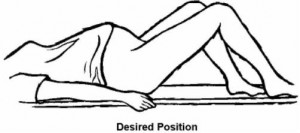a. Assess Patient for an Impending Precipitous Delivery Situation.
(1) Patient has previous obstetric history of rapid labor/delivery.
(2) Patient complains of a sudden, intense urge to push.
(3) Notable increase in bloody show.
(4) Sudden bulging of the perineum.
(5) Sudden crowning of the presenting part.
b. Call for Help.
Do not leave the patient unattended.
c. Obtain a Sterile Obstetric or Precipitate Delivery Pack, if Available.
The pack contains a variety of supplies to include towels, drapes, sanitary pads, and so forth. Priority equipment includes:
(1) Gloves – sterile gloves are preferred as they help promote asepsis, however, if non-sterile gloves are available they should be utilized as protection for the nurse.
(2) Towel/cloth-to provide a friction surface for control of delivery of the fetal head.
(3) Bulb syringe-for aspiration of amniotic fluid from the infant’s mouth.
(4) Hemostats or cord clamps-to clamp the umbilical cord.
(5) Scissors-to cut the episiotomy/cord.
(6) Dry blanket/towel-to wrap the infant after delivery.

d. Provide the Cleanest Environment Possible.
If no sterile equipment is available this should include:
(1) Paper, towel, blanket, or coat to place under the patient’s buttocks.
(2) Ligating material such as string, yarn, or shoelaces to tie the cord.
(3) A sharp instrument such as scissors, a knife, or a razor to cut the cord.
(4) A dry cloth to wrap infant after delivery.
e. Provide for Asepsis to the Greatest Extent Possible.
(1) Pour Betadine® over the patient’s perineum if time does not permit for perineal prep.
(2) Wash your hands and glove, if possible.
f. Support the Patient.
(1) Keep the patient informed of plans for delivery.
(2) Speak in a calm tone and provide direction to available assistants (e.g., significant other).
(3) Encourage the patient to pant or blow through contractions to slow the delivery process and to decrease the force of expulsion.
(4) Provide for privacy, but do not leave the patient alone.
